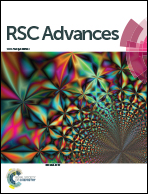Luminescence and electrochemical properties of rare earth (Gd, Nd) doped V2O5 nanostructures synthesized by a non-aqueous sol–gel route
Abstract
Vanadium pentoxide nanostructures have been obtained from an alkoxide sol–gel, prepared by a simple and inexpensive facile non-aqueous method. The progressive addition of rare earth (RE) ions (Gd3+, Nd3+) to pristine V2O5 and the structural, functional, morphological, optical and electrochemical properties were studied. XPS studies confirmed the presence of RE ions in the orthorhombic phase of pristine V2O5, which was supported by XRD. The doping of RE ions significantly altered the morphology of V2O5 into various nanostructures by the linkage of small V2O5 nanoparticles. A significant red shift from undoped V2O5 was observed from UV absorption and PL spectra. From the CV experiment, it was observed that the overall cell potential was increased for the doped samples. The specific capacity of the Gd3+ and Nd3+ doped V2O5 increased upto 10%, which is useful for secondary Li-ion rechargeable batteries.


 Please wait while we load your content...
Please wait while we load your content...